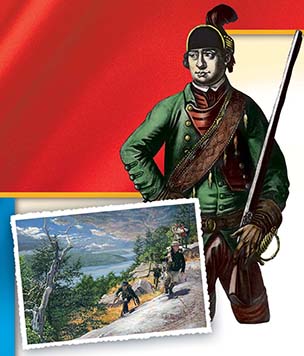SECTION 4: Wars of Empire

▲ Robert Rogers
▲ Rogers’ Rangers
WITNESS HISTORY  AUDIO
AUDIO
Rogers’ Rangers
The struggle for territory between England and France in North America broke into open conflict during the French and Indian War. From 1754 to 1763, the region between the Ohio Valley and Canada became a battlefield. To help win the war, England authorized units of Rangers—groups of colonial militiamen who served as scouts and soldiers—to aid English Crown soldiers. Rogers’ Rangers, led by Robert Rogers of New Hampshire, became famous for including Indians and freed slaves in its ranks and for its unusual but highly effective tactics. As Rogers explained, his goals were:
“… from time to time, to use my best endeavours to distress the French and their allies, by sacking, burning, and destroying their houses, barns, barracks, canoes, … and by killing their cattle … and at all times to endeavor to way-lay, attack and destroy their convoys of provisions by land and water, in any part of the country where I could find them.”
—Robert Rogers, 1756
Objectives
- Describe the causes and major events of the French and Indian War.
- Analyze the causes and effects of Pontiac’s Rebellion.
- Summarize how the wars and their outcomes changed the relationship between Britain and the colonies.
Terms and People
- George Washington
- French and Indian War
- Pontiac’s Rebellion
- Proclamation of 1763
- Albany Plan of Union
NoteTaking
Reading Skill: Recognize Sequence As you read, keep track of the sequence of events that led to the French and Indian War.
Why It Matters Conflict between the great European empires spread to the American colonies throughout the late seventeenth and early eighteenth centuries. The British and the colonists fought a series of wars against the French and their American Indian allies. In the process, however, the relationship between the British and their colonies became strained. Section Focus Question: How did Great Britain’s wars with France affect the American colonies?
European Competition and the Colonies
By the mid-eighteenth century, England, France, Spain, and the Netherlands were locked in a worldwide struggle for empire. In North America, Britain’s greatest rival was France. While Britain controlled the 13 colonies on the Atlantic seaboard, France controlled a vast territory that extended from the St. Lawrence River to the Gulf of Mexico.
Between 1689 and 1748, the British and the French fought a series of wars. Most of the fighting took place in Europe, but some spilled over into North America. Before long, British colonists were drawn into the war.
American Indians Affect the Balance of Power
Each war between England and France was followed by a treaty that resolved nothing. Great Britain longed to drive the French from North America, and to accomplish this, the British needed to neutralize the great





